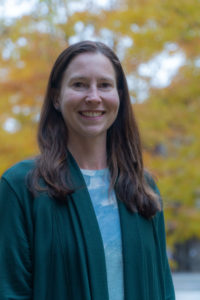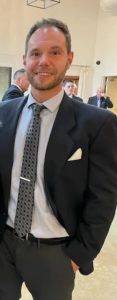
Two Ph.D. students in the Education, Equity, and Transformation program in Colorado State University’s School of Education left the American Association of Adult and Continuing Education Conference with awards for their novel research and significant findings.
“It gave me great motivation and a boost of confidence,” said Lauren Vilen, who won AAACE’s award for the most novel, relevant, and insightful topic for her research on adult self-directed learning in a community science bee monitoring program.
Vilen was also inaugurated as the director of AAACE’s graduate student commission and received a graduate student leadership award.
“It was a good reflection opportunity to realize that I really have accomplished a lot, not just in product outputs, but in my own thinking and knowledge development,” Vilen said. “I’ve really come a long way, and I should feel proud of that,” she said of receiving the awards.
“You’re so busy keeping your head down, so this was nice to come up for air and get some perspective,” said Thomas Rausch, who won AAACE’s top poster for significant findings or lessons learned award for his research on teaching for skill and knowledge transfer.
“Simply stated, learning for transfer is taking something you’ve learned in one situation and applying it to something else,” said Rausch.
“It helped show me that this research is worthwhile beyond my own interests and aspirations,” he said of receiving the award.
“I equated it to climbing a mountain. You just focus on the next step, and the next step, and you don’t look down. You just keep climbing,” Rausch said. “Then you get a chance to rest and look around. ‘Oh my gosh, it’s amazing, how far I’ve come.’”
In addition to receiving accolades at the conference, both Vilen and Rausch share a focus on how adult learners are motivated, and how they operationalize what they’ve learned.
Counting bees
 “My research revolves around where adult learners intersect with different types of ecological or environmental issues or topics,” Vilen said. “I’m interested in spaces where people are learning about things that matter to them through their own daily experiences.”
“My research revolves around where adult learners intersect with different types of ecological or environmental issues or topics,” Vilen said. “I’m interested in spaces where people are learning about things that matter to them through their own daily experiences.”
Vilen’s award-winning project studied volunteers in Native Bee Watch, a community science program run by CSU Extension, which monitors native bee populations throughout Colorado. Her research explored how volunteers learn and train themselves to monitor bees, identify different species, and confidently collect and submit data.
Volunteers are trained to observe specific small spaces in their backyards, and count and identify the bees that land on flowers in that area. Researchers use community science to gather more data than they otherwise would be able to.
“How are learners engaging in a self-directed learning process?” she asked. “We provide a lot of resources for them, and the training, but we’re really relying on them to figure this out on their own in the field.”
Before the COVID-19 pandemic, the program was conducted in person at public gardens and parks around Fort Collins and Denver. After the pandemic hit, the project went online and volunteers switched to collecting data in their home gardens.
With a pivot to online training, webinars, and other ways to keep community scientists involved, the program was able to expand beyond Fort Collins and Denver. The program had volunteers from all along the front range, and even some on Colorado’s western slope.
“Now, the volunteers are in their own space,” Vilen said. When interviewing volunteers, she said “many spoke about their own personal outcomes,” rather than the research itself. “They really like being able to be more in tune with their backyard environments. Some spoke of mindfulness.”
With the new distance set up, “there’s no one there to assist volunteers while they’re identifying bees in their backyards,” Vilen said.
Vilen’s research was about “the challenges volunteers experience, the strategies they developed for themselves to overcome those challenges and figuring out their own process for the monitoring sessions and data collection,” she said.
“That’s what the poster was about. How volunteers are describing that process,” she said. “I’m so impressed with how they stick with it and figure out these tricks for themselves to feel confident enough to submit data to this scientific project.”
“As an online learning program we can only do so much from afar when volunteers experience challenges in the field, but knowing what is important to people, matters to them, and helps them stay engaged and motivated, can help us determine where to put our limited resources,” said Vilen.
Learning that sticks

“Learning for transfer is a common concept in adult education and training spaces, but not as common in higher education,” said Rausch. “Working with adults is inspiring because they take what we teach them in so many different directions and applications.”
“In higher education, it’s more difficult because it isn’t a common goal, it just isn’t on people’s radar,” he said.
For students to successfully transfer their learning, both teachers and students need to engage in their respective educational processes with transfer in mind. It requires motivation, intention, and effort from both parties.
In order to facilitate learning for transfer, an instructor may ask students to critically think about their personal connections to the topics they are learning. “What are you going to do with what you’ve learned? Why does this content matter to you?” Rausch said. “A lot of that is up to the individual, an instructor can’t simply tell this to a student.”
“This is really about making learning a student-centered experience,” Rausch said. “And I think that flies in the face of what students are used to. They’re used to the teacher being the center of the learning process, and then telling back that information to the teacher via exams.”
“Instructors may resist teaching for transfer because they aren’t used to it, and it’s harder,” Rausch said. “For that reason, students will give instructors poor evaluations, and those evaluations affect how that teacher does their job.”
“This process leads to a cyclical system of disincentivizing teaching for transfer,” said Rausch.
For his award-winning project, Rausch interviewed professors who self-identified as those who “teach for transfer.”
“That’s a broad term, and we left it up to them to define for themselves,” Rausch said.
Rausch found that most professors who self-identified as using this teaching style did so because they were modeling a professor or mentor they themselves had. “They saw value in it themselves as students,” Rausch said.
“How awesome is it to be so inspired by a former teacher, that it influences how you want to teach?” said Rausch. “The problem is, if we’re trying to make this ubiquitous in higher education, you can’t rely on the providence of having a really awesome teacher yourself who inspires you.”
Rausch hopes that through his research, he can help move the needle in improving educational experiences for students by removing the barriers that currently exist for teaching for transfer.
“The best way to make change is to remove the barriers, not force it through,” he said.
The School of Education is part of CSU’s College of Health and Human Sciences.